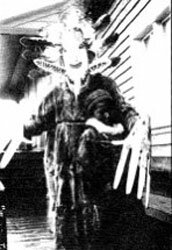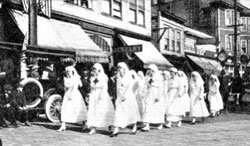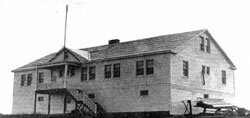
 |
|
||||||||||||||||||||||||
|
Alaska's Heritage
CHAPTER 4-21: HEALTH AND MEDICINE
Medical care in early American Alaska is limited Euroamerican explorers and traders introduced diseases against which Alaska Natives had no natural immunity. Smallpox, measles, and various strains of flu decimated the Natives. The population of some villages was reduced by more than 50 per cent from an epidemic of one of these diseases. The U.S. Army, and later the navy, assigned doctors to their Alaska posts beginning in 1667. The army operated a hospital at Sitka, in the old Russian hospital, between 1867 and 1877. The navy operated a hospital at Sitka between 1888 and 1697 and again from 1907 to 1912. Whaling ships and revenue service vessels sometimes had doctors aboard. As required by their 20-year exclusive fur seal hunting lease, the Alaska Commercial Company stationed doctors on the two large Pribilof Islands and at Unalaska. As economic activities expanded, some reining camps, canneries, and logging camps had nurses or doctors. Sheldon Jackson school at Sitka had a hospital after 1892. Still, medical care remained limited for people in remote areas of Alaska. Many had to travel hundreds of miles to obtain assistance. Doctors at mining carps or in small communities often offered insurance programs. At Candle in 1915, families who wanted insurance paid $4.50 a month. The doctor's salary vas $3,500 a year. To serve those they insured, it was not unusual for a doctor to travel a circuit to outlying camps up to 150 miles away. Missionaries provide much of the early medical care Missionaries provided much of the early health care in Alaska. The Episcopal church established eight hospitals in Interior Alaska, opening the first at Anvik in 1887. Others opened at Circle in 1696, at Fairbanks-in cooperation with the Roman Catholic missionaries-in 1903, at Allakaket in 1904, at Koyukuk in 1906, at Fort Yukon in 1906, at Tanana in 1910, and at Iditarod in 1917. Roman Catholic mission groups established hospitals at Nome, Holy Cross, and at Russian Mission in Western Alaska. Three Roman Catholic sisters of the order of St. Ann, Mary Zenon Fontaine, Mary Bonsecour Griff, and Nary Victor Dooly, opened a hospital at Juneau in 1886. Two years later they added a second building. The hospital kept expanding over the years. It closed in 1968. Dr. Joseph H. Romig, who arrived to work at the Moravian mission at Bethel in 1896, was that region's first resident doctor. During the winter, Dr. Romig traveled throughout the Yukon-Kuskokwim delta. He became fondly known as the dog-team doctor. Despite Dr. Romig's efforts, health care in Western Alaska was poor. More serious, when Dr. Romig left Western Alaska in 1906, a doctor did not replace him. Providing nominal medical care in Alaska is a challenge Many women worked as nurses in Alaska. Some, such as Alma Carlson, worked in isolated areas. Carlson spent 20 years in the arctic. She traveled great distances, winter and summer, to care for the sick or to encourage prevention of diseases. Her work was appreciated and she was paid well. In 1945, Carlson's annual salary was $3,450.  All Alaska Native groups had shamans who practiced fold medicine. The shaman was an important figure in Native communities. Collection Name: Alaska Historical Library, A.L. Angren Collection. Identifier: PCA 35-118 Around the territory, some communities organized American Red Cross chapters. The chapters provided important community services. Members trained people in emergency first aid, provided home nursing care, distributed information on nutrition and preventive medicine, and assisted during disasters such as floods. In 1943, Alaska had 10 active Red Cross chapters. Mental health care is unavailable  American Red Cross chapters organized in Alaska during the 1910s. Here, the workers are joining in a parade at Juneau in 1918. Collection Name: Alaska Historical Library, Case and Draper Collection. Identifier: PCA 39-518 After 1901, Alaskans judged insane went to Morningside hospital at Portland, Oregon. When a person could not be taken to Morningside until spring, he or she was jailed with criminals. By 1942, over 2,000 persons from Alaska had been admitted to Morningside hospital. Congress finally approved construction of a facility in Alaska in 1956. The Alaska Psychiatric Institute was built at Anchorage. It was turned over to the new State of Alaska to operate in 1959. The Bureau of Education takes responsibility for Alaska Natures' health care In the early 1900s, the Bureau of Education began working to improve health care in isolated villages. During the summer months, doctors and nurses aboard the bureau's supply ship Boxer held clinics wherever the ship anchored. A nurse or physician traveled through rural Alaska by dog team during the winter months. Still, medical care for rural Alaska was inadequate. During the 1930s, Northwest Alaska had one doctor and two nurses at Barrow, a nurse at Wales, and a doctor at Nome. The Bureau of Education received a special appropriation in 1915 to build a 25-bed hospital for Alaska Natives at Juneau. Over the next 15 years the bureau opened hospitals for Alaska Natives at Akiak, Noorvik, Unalaska, and Tanana. After the influenza epidemic of 1918-1919, the bureau also operated several orphanages.  Missionaries opened and operated hospitals in many rural areas of Alaska. This hospital was built during the 1930s at Point Barrow. Collection Name: Alaska Historical Library, U.S. Coast Guard Collection. Epidemics are hard to control Alaskans continued to fear epidemics. An influenza (pneumonia and fluff epidemic raged through the Aleutian Islands and Southwest Alaska in 1900. Referred to as the Great Sickness, it killed entire populations in a number of villages. The severe world-wide influenza epidemic ravaged the same area, and Northwest Alaska as well, in November, 1918 and continued through the following summer. To combat the killing disease, several villages on the Seward Peninsula posted guards who prevented anyone from entering their boundaries. There were other diseases that reached epidemic proportions and swept through the territory-measles, whooping cough, diptheria, mumps, and polio, to name a few. Remembering the devastating effects of the influenza epidemic of 1918-1919, when diptheria was suspected in Nome during the winter of 1925 the community requested that serum to combat the disease be sent to them as quickly as possible. In response, serum was rushed to the people of Nome from Seattle. A ship carried the serum from Seattle to Seward, where it was carried by the Alaska Railroad to Nenana, then by dog teams to Nome. Twenty individuals transported the serum the 674 miles between Nenana and Nome in 127 1/2 hours. Tuberculosis is Alaska's number one disease During the first half of the twentieth century, tuberculosis was the most damaging disease in Alaska, killing and crippling many people. Tuberculosis (TB) was a communicable disease that most often affected a person's lungs or bones. It is uncertain when tuberculosis first appeared in Alaska, but it was well established by the end of the eighteenth century. The incidence of tuberculosis in Alaska during the 1900s was many times greater than in the rest of the United States. In Southeast Alaska, the death rate from tuberculosis in 1932 was 1,302 per 100,000. The rate among non-Natives in the U.S. was 56 per 100,000. A survey in the 1940s showed that three-quarters of the children in the Yukon-Kuskokwim delta had tuberculosis. Before effective drugs became available; persons with active cases were isolated in hospitals or sanatoriums to prevent spreading the disease. Alaska's first sanatorium was at Skagway. By the mid-1940s, some 4,000 active cases had been identified in the territory, but only 70 hospital beds were available. Chemotherapy with new drugs finally proved successful in fighting tuberculosis. The territorial government launched a major effort to combat tuberculosis and promote better health in 1946. Governor Ernest Gruening appointed Dr. C. Earl Albrecht as the first full-time territorial commissioner of health. A program to train village chemotherapy aides began. Mobile health units operated on the highways and the Alaska Railroad. Two ships, the Hygiene and the Health, traveled to communities on the Aleutian Islands and west coast of Alaska to bring health care to the coastal villages. The Yukon Health traveled up and down the Yukon River. Children nick-named these vessels "shot ships" because the stops meant vaccinations against smallpox, measles, and other diseases. The territory opened a 150-bed sanatorium at Seward in 1946. The next year a U.S. Navy facility at Mt. Edgecumbe near Sitka was renovated. This 200-bed sanatorium was for children with bone tuberculosis. Others went to Seattle for treatment. In 1953, the 400-bed Alaska Native Hospital in Anchorage opened as a center for treatment of tuberculosis. For many, going to one of these treatment centers was their first long stay away from their villages. Many found that being away from family, friends, and familiar surroundings was difficult. The fight against tuberculosis in Alaska continued into the early 1970s. The death rate from tuberculosis for Alaska Natives had declined from 653 per 100,000 in 1950 to the vanishing point. The U.S. Public Health Service takes over In 1955, responsibility for health services for Alaska Natives transferred from the Bureau of Indian Affairs' Alaska Native Service to the U.S. Public Health Service. Nurses traveled to villages giving immunizations, teaching residents about good health, and providing medical assistance. The old Juneau hospital closed in 1958. New hospitals were built in Kotzebue in 1961 and Barrow in 1965. Hospitals at Bethel, Kanakanek, and Anchorage were renovated during the 1960s. A community health aide program was funded in 1968. Individuals selected by the community members received training, usually at the Alaska Native Medical Center at Anchorage. Back in the villages, aides administered shots and, when emergencies arose, contacted doctors at regional hospitals. At the same time, doctors and dentists began to make regular field trips. A regular radio medical network was developed. In the 1980s, Alaska's great distances continued to challenge those providing medical care. In addition, health care remained expensive. Travel was costly, and often unpredictable due to weather. Salaries were high. Supplying villages with necessary medical supplies and adequate equipment was expensive, but improved health and brought care close to home.
|
|||||||||||||||||
|